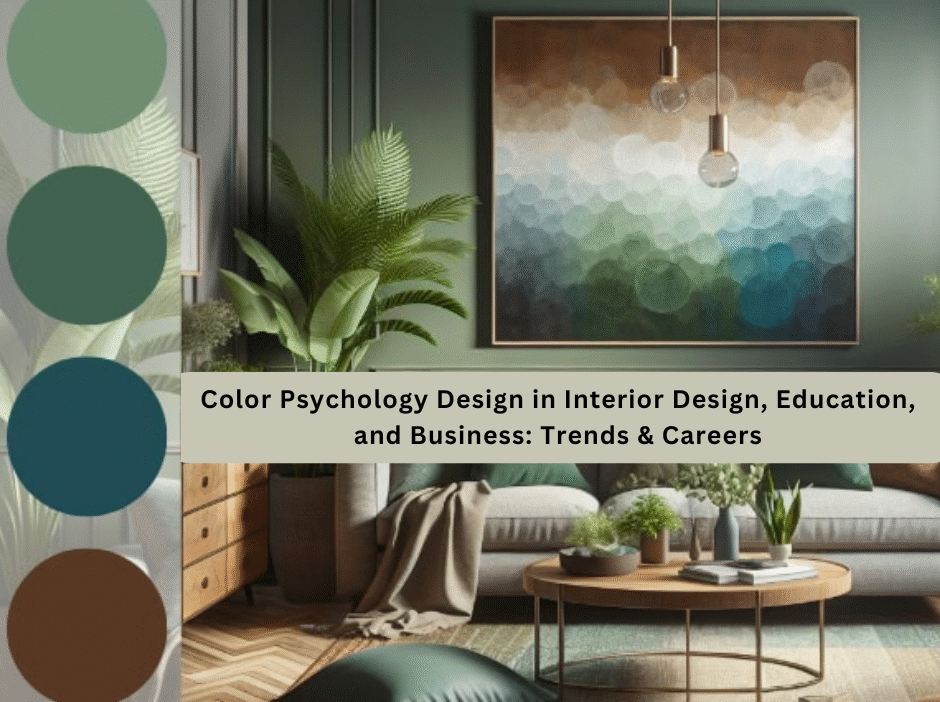Design is no longer just about how things look—it’s about how they make us feel. In 2025, color psychology design is emerging as a key player in shaping experiences across industries, from interior design to business branding, education spaces, and more. Whether you’re designing a home, a product, or a retail environment, the emotional impact of color can’t be ignored.
Let’s explore how color psychology design is changing the game, the latest trends, the types of design courses that teach it, and where this skill can take you.
What is Color Psychology Design?
Color psychology design refers to the use of color to influence emotions, behavior, and decision-making. It’s rooted in psychology and used intentionally in design to create specific atmospheres or responses.
For example:
- Blue is calming and promotes trust—often used in offices and banks.
- Red stimulates urgency and appetite—used in sales or food branding.
- Green is linked to growth and wellness—perfect for education and health spaces.
In 2025, brands and designers are applying these insights more thoughtfully than ever, not just for visual appeal but to shape how people interact with spaces, products, and content.
Where Color Psychology Design is Making an Impact
- Interior Design
In modern interior design, color choices are strategic. Designers are using softer, earth-toned palettes for mental well-being, and bold accent walls to energize living spaces. A popular application is in drawing room interior design, where neutral tones paired with statement colors create both calm and conversation.
Trend for 2025: Expect to see more muted greens, terracotta, and warm greys—tones that bring balance and emotional grounding. - Business & Branding
Businesses are investing in branded environments—think retail stores, co-working spaces, or even product packaging—where colors are chosen to drive customer behavior. Startups are using vibrant palettes to communicate innovation, while luxury brands lean into monochrome or deep, rich hues for elegance. - Education
Schools and universities are redesigning classrooms using color psychology design principles to support focus, creativity, and calm. Classrooms now use blue or green for reading corners, yellow for creative zones, and soft lighting with calming tones for meditation or quiet spaces. - Healthcare
Hospitals and clinics are shifting away from sterile white walls to use color for healing and comfort—soft blues, lavenders, and peach tones are now being used to reduce stress and anxiety. - Management & Workplaces
In leadership and management training environments, colors like green (growth), orange (enthusiasm), and grey (balance) are being used to subtly reinforce brand values and workplace culture.
Types of Design Courses That Teach This
If you want to build a career that uses color psychology design, there are many types of design courses to consider. These courses don’t just teach aesthetics—they teach purpose-driven design.
- Interior Design: Focuses on creating functional and emotional living/work spaces.
- Visual Communication Design: Covers branding, digital media, and visual storytelling.
- UX/UI Design: Teaches how to use color for digital user behavior and emotional response.
- Environmental Design: Deals with large-scale spaces—malls, airports, public parks.
- Product Design: Teaches how to integrate form, function, and user emotion.
Courses now often include modules on color theory, human psychology, and design thinking—all crucial for applying color psychology effectively.
Scope and Career Opportunities in 2025
As industries become more people-focused and design-aware, the demand for professionals trained in color psychology design is rising fast. Here are just a few career paths:
- Interior Designer: Specializing in wellness-focused or emotion-centered spaces.
- Brand Consultant: Helping companies align visual identity with customer emotion.
- UX Designer: Creating digital products that feel intuitive and emotionally resonant.
- Retail Space Designer: Using color and layout to boost customer engagement.
- Educational Space Planner: Designing schools with color zones that support learning.
- Design Psychologist: An emerging role that blends psychology and design principles.
The best part? These careers span across sectors—tech, healthcare, hospitality, education, and even urban planning.
Suggestions for Aspiring Designers
- Start With Color Theory: Learn the basics—hue, saturation, contrast, and how colors interact.
- Study Human Behavior: Even a basic understanding of psychology gives you an edge in designing with purpose.
- Practice With Real Spaces: Try redesigning your own room or a digital layout using different color palettes. Observe how mood changes.
- Take a Specialized Course: Look for design institutes or programs that offer modules specifically on color psychology design.
- Follow Trends, But Think Long-Term: While trends shift, emotional resonance lasts. Think beyond fads.
Final Thoughts
In 2025 and beyond, color psychology design isn’t just a trend—it’s a core tool for effective design thinking. Whether you’re redesigning a drawing room interior design, launching a brand, or planning a new learning environment, the ability to use color with purpose makes all the difference.
With the right education—through specialized types of design courses—and an understanding of human behavior, the opportunities are endless. From interior design to tech, business to education, color is more than decoration. It’s communication.



